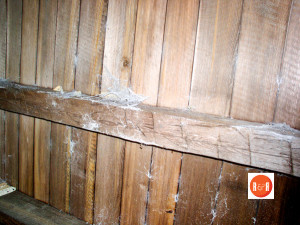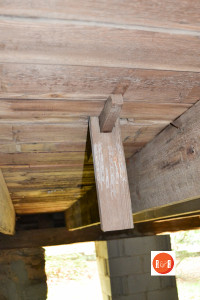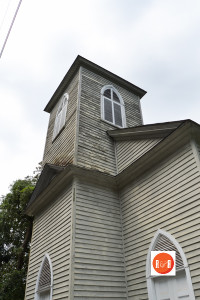159 Burns Street
City Directories and History: This lovely church was built in 1834 and has remained intact. Originally costing only $1,150., the structure remains Darlington County’s earliest church building.
The “Redundant” Trinity Episcopal Church History – Written and contributed to R&R by Bill Segars – 2015
In the sleepy little town of Society Hill sits a seldom seen jewel of religious history for Darlington County and South Carolina. Hundreds, possibly thousands of people drive within 150 yards of it daily and do not realize what they are missing. At 159 Burns Street, just off of Highway 15 in Society Hill, Trinity Episcopal Church sits empty, eagerly awaiting each year’s annual service when it come back to life with song, prayer and fellowship.
Trinity Episcopal Church was established on December 19, 1833 by seven men and their families to serve the needs of the local Episcopalians who had been previously worshiping with the St. David’s congregation in Cheraw. Immediately upon organization, the group set out to gather building materials and raise the money needed to build their own church building. In four months the group had erected the present build on a lot which was donated by Elias Gregg for a cost of $1,150. On April 25, 1834 The Rt. Rev. Nathaniel Bowen, D. D., Bishop of the Diocese of South Carolina, consecrated Trinity Church as “A house suitable for the worship of Almighty God”.
 Two of the men that were involved in the establishment of Trinity were Major John Dewitt and his son-in-law John McCullough. John McCollough’s son John Dewitt McCollough, born in Society Hill on December 22, 1822, became very close to Trinity’s first rector The Rev. M. M. Wheeler and found himself intrigued with the construction process at Trinity. When the building was consecrated on April 25, 1834, the eleven year old McCollough gave five dollars of his own money towards the construction and placed his prayer book in the cornerstone of the new Episcopal Church. Why is this important for not only Trinity but for South Carolina also? John Dewitt McCollough went on to become an ordained priest in the Episcopal Church and helped to design and build twenty-two churches in South Carolina and one in North Carolina, most of which have similar Gothic design features as seen in his home church of Trinity.
Two of the men that were involved in the establishment of Trinity were Major John Dewitt and his son-in-law John McCullough. John McCollough’s son John Dewitt McCollough, born in Society Hill on December 22, 1822, became very close to Trinity’s first rector The Rev. M. M. Wheeler and found himself intrigued with the construction process at Trinity. When the building was consecrated on April 25, 1834, the eleven year old McCollough gave five dollars of his own money towards the construction and placed his prayer book in the cornerstone of the new Episcopal Church. Why is this important for not only Trinity but for South Carolina also? John Dewitt McCollough went on to become an ordained priest in the Episcopal Church and helped to design and build twenty-two churches in South Carolina and one in North Carolina, most of which have similar Gothic design features as seen in his home church of Trinity.
This balloon construction building that exists today is basically the same building that was erected in 1834, with very little changes or alterations. There is a good chance that what you see and touch today at Trinity was put there in 1834. The addition of a chancel was made under the direction of The Rev. J. S. Kidney for a cost of $2,000 when he was rector at Trinity between 1858 and 1865.

Images of the church taken by photographer Bill Segars.







The other notable change has been the addition of an organ that was installed between 1873 and 1880 when The Rev. Tucker Lee was rector at Trinity. The organ was manufactured by W. B. D. Simons and Co. of Boston M.A. and installed at a cost of $1,250, which is $100 more than the church building cost when it was built in 1834. The organ was originally a hand pump organ and it was very often the responsibility of the children of the church to pump the organ during the services. Electricity has never been installed in the building, so now that the organ has a fan in lieu of the hand pump operation, an electrical cord is extended to an offsite service pole for electricity on the annual service.
The strong building and supportive community has withstood the test of time for over 181 years. The Charleston Earthquake of 1886, August 31, 1886 rocked the then 52 year old building and steel rods, commonly called “Earth Quake Rods”, were added to hold it together. These rods are still visible today under the building along with the original wooden pegs and carpenter marks. Preventive maintenance has been done over the years in the fact of new roofing, painting, foundation repairs and general small carpentry repairs. These repairs have been paid for with funds lovingly donated by former member, historically interested individuals and generous donations at the annual services. Without these caring folks, the building may have met the same fate as the congregation itself did.
Stay Connected
Explore history, houses, and stories across S.C. Your membership provides you with updates on regional topics, information on historic research, preservation, and monthly feature articles. But remember R&R wants to hear from you and assist in preserving your own family genealogy and memorabilia.
Visit the Southern Queries – Forum to receive assistance in answering questions, discuss genealogy, and enjoy exploring preservation topics with other members. Also listed are several history and genealogical researchers for hire.
User comments welcome — post at the bottom of this page.
In 1930, due to declining membership and attendance, Trinity closed as an active church. Unfortunately the original church records were destroyed in a residential fire in 1934, so any known historical accounts have been reconstructed from memory by the older members.
Please enjoy this structure and all those listed in Roots and Recall. But remember each is private property. So view them from a distance or from a public area such as the sidewalk or public road.
Do you have information to share and preserve? Family, school, church, or other older photos and stories are welcome. Send them digitally through the “Share Your Story” link, so they too might be posted on Roots and Recall.
Thanks!
IMAGE GALLERY via photographer Bill Segars
User comments always welcome - please post at the bottom of this page.















Share Your Comments & Feedback: